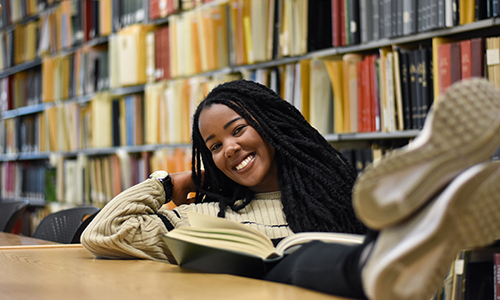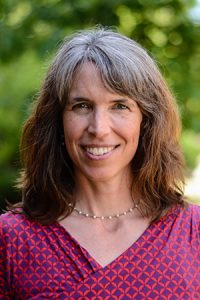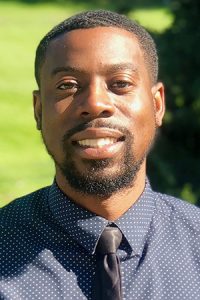 Our first teachers are the village of people that surrounded us growing up. Our own world in higher education is constructed on the history of our education as much as it is based on our identity within our families, our culture, our home, and every place and experience between birth and now.
Our first teachers are the village of people that surrounded us growing up. Our own world in higher education is constructed on the history of our education as much as it is based on our identity within our families, our culture, our home, and every place and experience between birth and now.
Identity, pedagogy, and leadership principles were the topics of a recent conversation with Associate Professor of Language and Literacy for Linguistic and Racial Diversity in the Department of English Lamar Johnson, and Assistant Professor in the Department of Teacher Education Carrie Symons, both 2021 Lilly Fellow honorees.
Inspired Teaching
“Inspired teaching is learning who your students are as people first and foremost and then as learners. It’s bringing our whole selves into work. Leadership is letting students see how we are learning and being transparent about it.” said Symons.
The theme that resonates throughout the conversation is that inspired teaching is self in action – as you invest in yourself, your research, your service, and your pedagogy – it’s interconnected, not detached. “What is curriculum? It’s not just standards and indicators, papers, and activities. We are also the curriculum – we choose our pedagogy and lesson plan. It is also autobiographical,” said Johnson.
He goes on to say that, “Inspired teaching looks like soul work. You have to go through the rebirth – the introspective work. Real teaching is radical love and Black Joy* for me. This is not just a surface-level classroom. It is deeper than that. We start with ourselves and how we are implicated in the struggle for racial justice. Inspire through stories. Engage through pedagogy. Teaching is so dynamic. You can bring it to anything and it is so beautiful. As a teacher, you have to have wonder and joy. Bring that into the classroom.”
Learning Together
Johnson also brings a sense of excitement and unity into conversations. He encourages educators to set up a classroom culture where they and the students are a community of learners so that it’s bidirectional. Entering a classroom as a facilitator opens the dynamic for educators to be both a teacher/learner and the student to be a teacher/learner.

Carrie Symons
Symons facilitated just such an environment during a doctoral apprenticeship program that connected refugee-background multilingual high school and college students to MSU doctoral students from the College of Education. “The doctoral students were teaching/mentoring and the youth themselves ended up being great mentors to us. WE all learned from each other!” said Symons. In community-engaged scholarship, researchers are encouraged to put themselves in the position of learners in the community and let the mentees lead. Often the research agenda and goals are co-constructed. Symons recommends that scholars not come in with a plan, and instead come together to learn about each other to figure out how to work together. This model allows necessary ambiguity because building relationships and rapport is more challenging.

Lamar Johnson
Johnson created a similar experience of teaching teachers by developing a Racial Storytelling Workshop series that involved critical self-reflection. He shares the idea that the past, present, and future work together in storytelling. Racial storytelling is used to move thinking forward – first, by recounting memories from the past, then using the theories to reframe the stories. He asks educators to consider, “How did what we learn or experience in the past apply through the different racial justice framework?” Together they reviewed the classroom syllabus and deconstructed it. This process included looking at the readings, the authors, the theories used in the course, and what was driving the assessments. After the workshop, educators were able to reconstruct the classroom syllabus using the reframed mindset.
Lilly Fellowship
The cohort of Lilly Fellows for the 2020-2021 academic year included Johnson and Symons. This fellowship program aims to develop academic leaders who will guide the University into the near future with regard to learning, teaching, and educational programming. Participants in the esteemed fellowship are expected to focus their work on a project of their choosing that will make a substantial contribution to a unit’s educational efforts. Using the proposed project as a foundation, participants also learn leadership concepts and models, build specific skills, learn more about how the University works, and practice what they learn through the activities of their project and small group mentoring and coaching.
“The program was an opportunity to study my own teaching and was really exciting. The program provided permission, incentive, space, and community to do the research into our own teaching. It was a space to care deeply about the people and the work.” said Symons.
The Lilly Fellowship Program explored the concept of leadership as identity. The cohort was asked to think creatively about leadership within their current role and as a trajectory for individual and overall organizational growth.
For Johnson, the question was, “How do I take what I’m doing in equity into leadership for racial justice? What does leadership look like?” The Lilly Fellowship gave him the ability to connect with other educators across campus who worked in different colleges and departments to discuss many ideas about teaching, learning, and leadership in academia.
Leadership
“Leadership, just as teaching – is dynamic. This is not a place for people who are too fearful to do the work. As the leader you have to put yourself out there,” said Johnson.
The qualities of leadership is a topic Symons thought deeply about, defining a leader as someone who can be responsive to ebbs and flows of the different demands from a variety of stakeholders. She said that great leaders would have discernment in terms of figuring out how best to listen and to do so in a way that is taking responsibility for themselves, at the same time constantly and iteratively considering the needs of others.
Symons went on to say, “Leaders who are truly strong are strong because they are willing to show their humanity – it’s multidimensional. They can be honest about their own shortcomings, biases, and limitations and they recognize that if we are going to get anywhere we are going to get there together. True leaders realize their role is to build a community. They bring out leadership in everyone they work with.”
Village of Educators
Great leaders learn from their community. Johnson recalls that his first teachers were his mother, father, aunts, cousin, and grandparents. It was in the first grade that he was Inspired to get into teaching when he had his first male teacher. “Since then I have wanted to be a teacher. In my family, friends, and church involvement there were a lot of Black teachers. The true teachers were the Black village growing up. In college, there were Black educators who inspired me. I saw what real soul teaching looked like.” The idea of soul teaching started young for Johnson and has clearly influenced his own teaching style as he radiates the Black Joy of his identity into work and the people around him.
It is clear from the conversation that in order to engage in the work of teaching and learning educators must constantly connect with themselves as teachers and then with students. Through this kind of human connection; learning becomes very rich and generative.
Symons says she inspires others by helping them understand who they are, what they care about, and how that connects in their field. “Doctoral students with whom I have worked are encouraged to find their own path, discover what gives them energy and what they are passionate about, and think about the way they want to impact the world,” said Symons. She inspires educators to consider how they too can be a leader, an inspired teacher, and a continual learner.
Action Options
Learn more about the Lilly Fellowship program.
Preview the film trailer and download educational materials created by Symons in partnership with the Refugee Development Center.
Check out Johnson’s book – Critical Race Education.
A parting thought from Johnson: “Some people refuse to get in on change and move forward. It scares them. But think about who benefits and who loses when you don’t move forward?”
*Black Joy is exuberant and fluid, beautiful and rough. It’s limitless. Black Joy is the celebration of making a way out of no way, making a space in a place that wasn’t created for them. Black Joy is resistance, love, hope, grounded in the Black radical imagination – hope for what is not yet, but is to come. Black Joy is creativity, art, music. It’s self-loving, reflecting, and building. It’s filling yourself to overflow into others. It is a rise to hope over injustice, grown stronger through each generation. (back to place in article)

